Bird News from Nial Moores
Baekryeong Island, Ongjin County, Incheon, is a large offshore island lying 14km north of Socheong and at closest only 13km from the DPRK mainland. There was quite poor visibility on all three days of survey (with fog on the 7th and the morning of the 8th followed by yellow dust). Winds were light to moderate throughout and temperatures above average (with maxima of 6C on 7th, 13C on 8th and 11C on 9th) as a result of a record-breaking pulse of warm air pushing across eastern China and southern ROK (max. of 25C apparently recorded in Daegu on 11th).
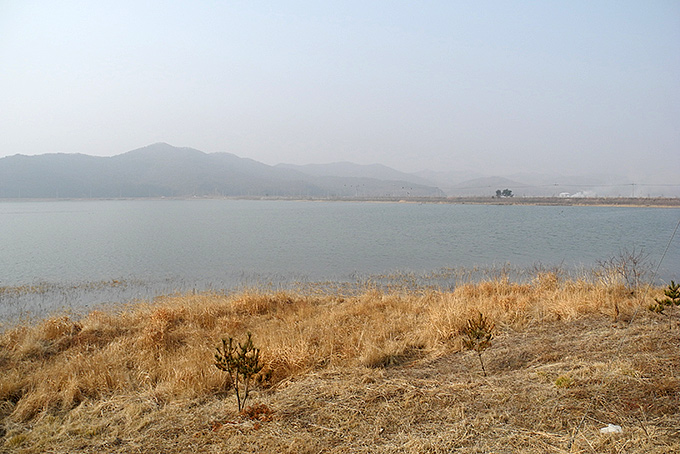 Baekryeong Lake, northern end, Photo © Nial Moores
Baekryeong Lake, northern end, Photo © Nial Moores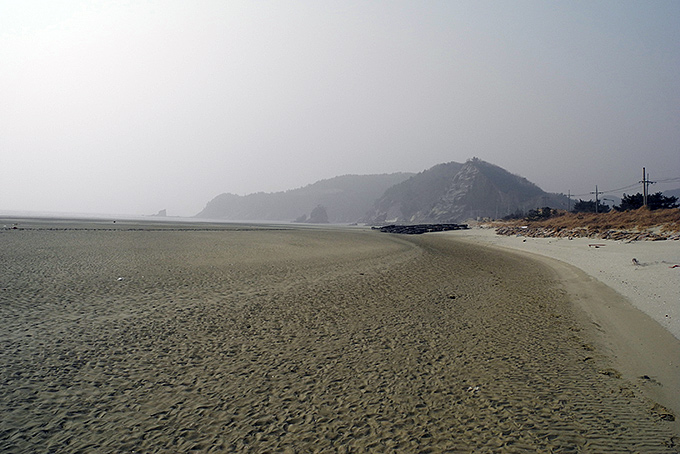 Baekryeong Do, southern beach, Photo © Nial Moores
Baekryeong Do, southern beach, Photo © Nial Moores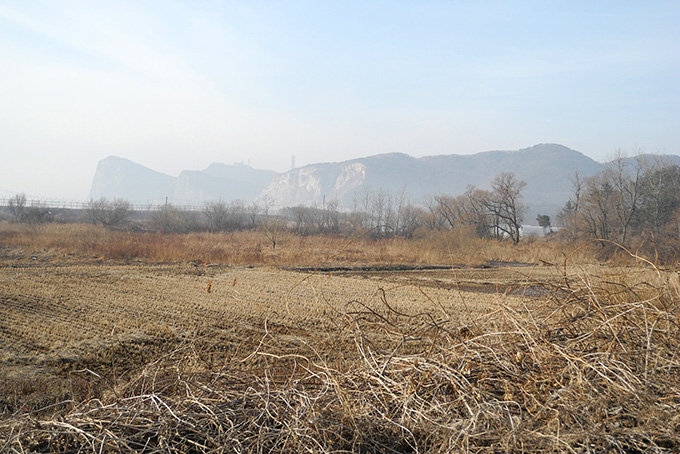 Baekryeong Do, mixed habitat near Hyeonhwa Ri, Photo © Nial Moores
Baekryeong Do, mixed habitat near Hyeonhwa Ri, Photo © Nial Moores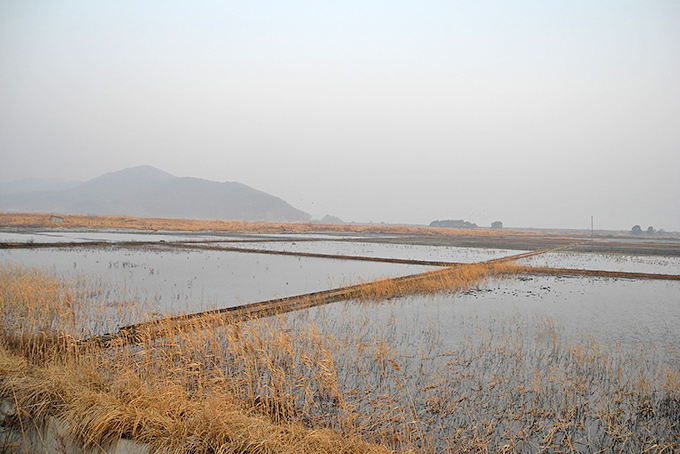 Baekryeong Do, wetland behind the salt pans at Hwado Ri, Photo © Nial Moores
Baekryeong Do, wetland behind the salt pans at Hwado Ri, Photo © Nial MooresAll birds (seen and heard, irrespective of distance) were counted on foot in 15 coarsely-delineated areas during 23 hours of survey between dawn and dusk. The first afternoon (marked by yellow dots) was spent in the east of the island; day two (marked in green) in rice-field areas, as far west as Hyeonhwa Ri; and day three (marked in blue) was focused on open habitats and forest edge towards the southwest of the island. As elsewhere, this kind of survey is strongly biased towards the recording of species which are vocal and/or typically found in open habitats.
 Baekryeong Island, with survey routes marked by coloured dots, Photo © Nial Moores
Baekryeong Island, with survey routes marked by coloured dots, Photo © Nial MooresA total of 84 species were logged (none of which were owls, despite several hours spent walking in the dark). Several of the species that were recorded appear to be early spring migrants (based on research on other islands), with sudden warming on the 8th and clearing fog apparently soon followed by larger numbers of several species (including both species of rosefinch). However, as the island is not covered by the MOE winter census and is rarely visited by Birds Koreans it is also possible that many of the same species (and individuals…) also overwintered here.
The most numerous species recorded this trip was Tundra Bean Goose (with >1000 present), with the five most numerous landbird species Rustic Bunting (155 in 9 areas), Eastern Great Tit (101 in 13 areas), Yellow-throated Bunting (72 in 12 areas), Rook (85 in one flock), and Pallas’s Reed Bunting (70 in six areas).
Further selected highlights included:
Japanese Quail: One on 7th.
Mandarin Duck: One male on Baekryeong Lake (a large reclamation lake in the centre of the island visited on all three dates) on 8th.
Falcated Duck: At least 10 on Baekryeong Lake on all three dates.

Mallard x Eastern Spot-billed Duck hybrid: One poorly digiscoped on 7th appeared to be paired with a pure Eastern Spotbill.
Baikal Teal: One male on Baekryeong Lake on 8th.
Black Kite: Two at Sagot Ri on 7th and one (still largely in juvenile-type plumage) in rice-fields west of Jincheon on 9th. This species is absent from almost all of the ROK with the exception of the far southeast and was not listed for the adjacent Hwanghaenam Province (DPRK) by Tomek, but was also recorded here in December 2007 by Robin Newlin (see Bird News archive).
White-tailed Eagle: At least five or six present, most close to Baekryeong Lake.
Steller’s Sea Eagle: An immature was soaring with White-tailed Eagles at Hwadong Ri on March 9th.
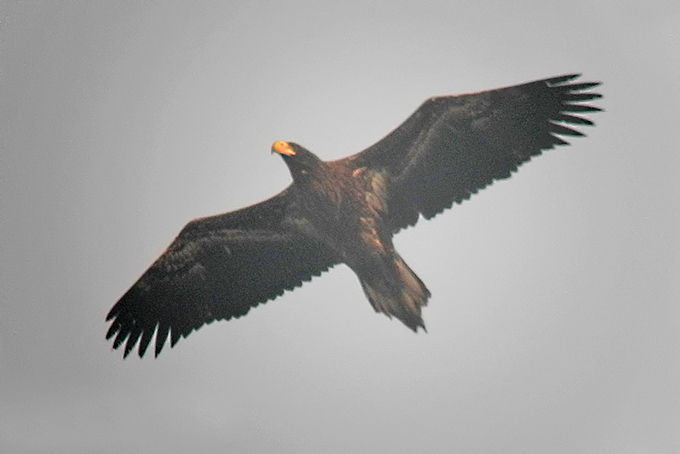 First-winter) Steller’s Sea Eagle Haliaeetus pelagicus (same as in previous image), Photo © Nial Moores
First-winter) Steller’s Sea Eagle Haliaeetus pelagicus (same as in previous image), Photo © Nial MooresUpland Buzzard: Although this has been a rather poor winter for the species on the mainland probably six were recorded in total, with three or four First-winters and two or three adults. It is possible that several of these were early spring migrants as March appears to be the peak month for northward migration along the west coast.
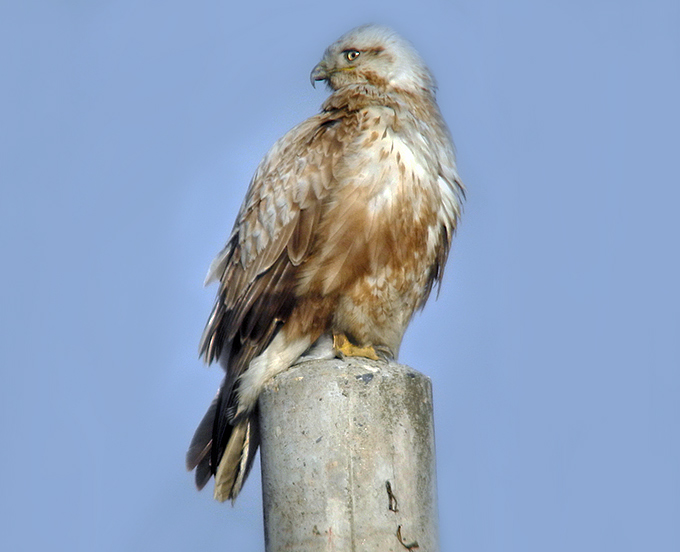 First-winter Upland Buzzard Buteo hemilasius, Photo © Nial Moores
First-winter Upland Buzzard Buteo hemilasius, Photo © Nial MooresEastern Buzzard: A total of 21 were counted in 11 areas, including one odd-looking individual at Hwadong Ri on the 9th with a warm-toned breast, solid looking dark belly, and obvious large white patches on the primary bases.
“Far Eastern Oystercatcher”: Six were display-flighting together over the salt-pans at Hwadong Ri on 9th suggesting the possibility of local breeding.
Little Ringed Plover: Singles on 7th and 8th were the personal first of the year.
Spotted Redshank: One on 8th was the personal first of the year.
Eurasian Hoopoe: One on 7th and a second on 8th were the only ones recorded.
Chinese Grey Shrike: One was in song in rice-fields east of Baekryeong Lake on all three dates and a second was at Kaul-Ri on 8th.
Azure-winged Magpie: Five were in Sagot Ri on 7th. This is my first encounter with this species on any offshore island. Of note, however, Park Jin Young’s 2002 thesis includes a series of records of the species on Baekryeong, including a maximum of 60 in September 1991.
 Azure winged Magpie Cyanopica cyanus, Photo © Nial Moores
Azure winged Magpie Cyanopica cyanus, Photo © Nial MooresHorned Lark: An extremely elusive individual was seen and heard twice in flight in two hours mixed in with a group of 15 or so Eurasian Skylark in Hyeonhwa Ri (in the far west of the island). In bright light, the strong yellow wash on much of the head indicated subspecies flava. No images or sound recordings were made. This is likely a much-overlooked species in the ROK, as there have now been several recent records – all along the west coast in months Oct-Apr.
Light-vented Bulbul: Two were in Sagot Ri on 7th and another probable was heard on 8th in the west of the island. With mid-winter records in previous years also from e.g. Socheong and Ganghwa it seems that this species is able to survive some of the nation’s harshest winter weather…
 Light-vented Bulbul Pycnonotus sinensis, Photo © Nial Moores
Light-vented Bulbul Pycnonotus sinensis, Photo © Nial MooresWhite Wagtail: A total of 20 were recorded in 11 areas, with all birds seen leucopsis (an early spring migrant and summer visitor to the ROK).
Eurasian Bullfinch: Seven were heard in three areas.
Long-tailed Rosefinch: A total of 18 were logged in eight areas.
Pallas’s Rosefinch: None on 7th; only one high-flying bird on 8th; but at least 30 on 9th (including several fully adult males).
Chestnut-eared Bunting: Three were in the main stream at Hyeonhwa Ri on 8th.
Common Reed Bunting: Probably 15 or so were present in overgrown fields to the east of Baekryeong Lake Bill size and shape suggest (as expected) subspecies pyrrhulina, said to breed in Kamchatka, Eastern Siberia, north-eastern China and northern Japan, and to winter more widely in East Asia (including in the ROK, where it appears to be increasing rapidly).
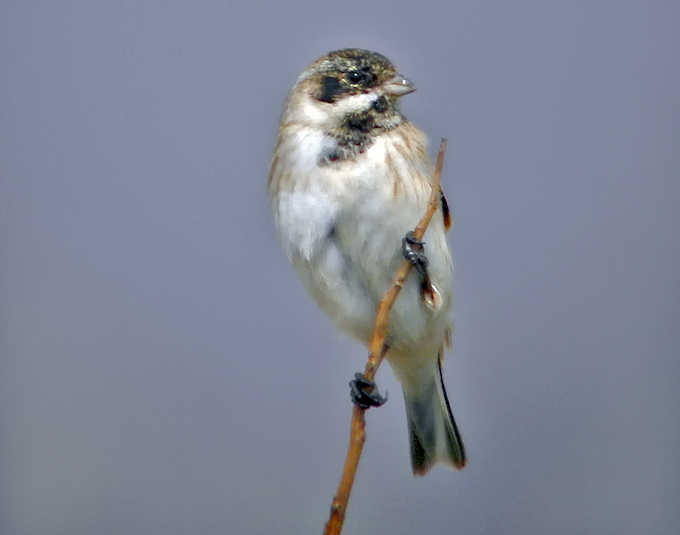 Common Reed Bunting Emberiza schoeniclus pyrrhulina, Photo © Nial Moores
Common Reed Bunting Emberiza schoeniclus pyrrhulina, Photo © Nial Moores Female Common Reed Bunting Emberiza schoeniclus pyrrhulina, Photo © Nial Moores
Female Common Reed Bunting Emberiza schoeniclus pyrrhulina, Photo © Nial MooresTo conclude, despite the patchily heavy-construction much excellent and quite diverse habitat remains on Baekryeong. The walking is easy and several of the birds seem fairly approachable. It is therefore likely that in the right conditions and at the right times of year birding on Baekryeong could be superbly informative and hugely enjoyable. Moreover, in spite of all the televised belligerence and anger-mongering of recent weeks (similar to several recent Marches), local people seemed relaxed and extremely friendly. Here is hoping that things long remain that way!
